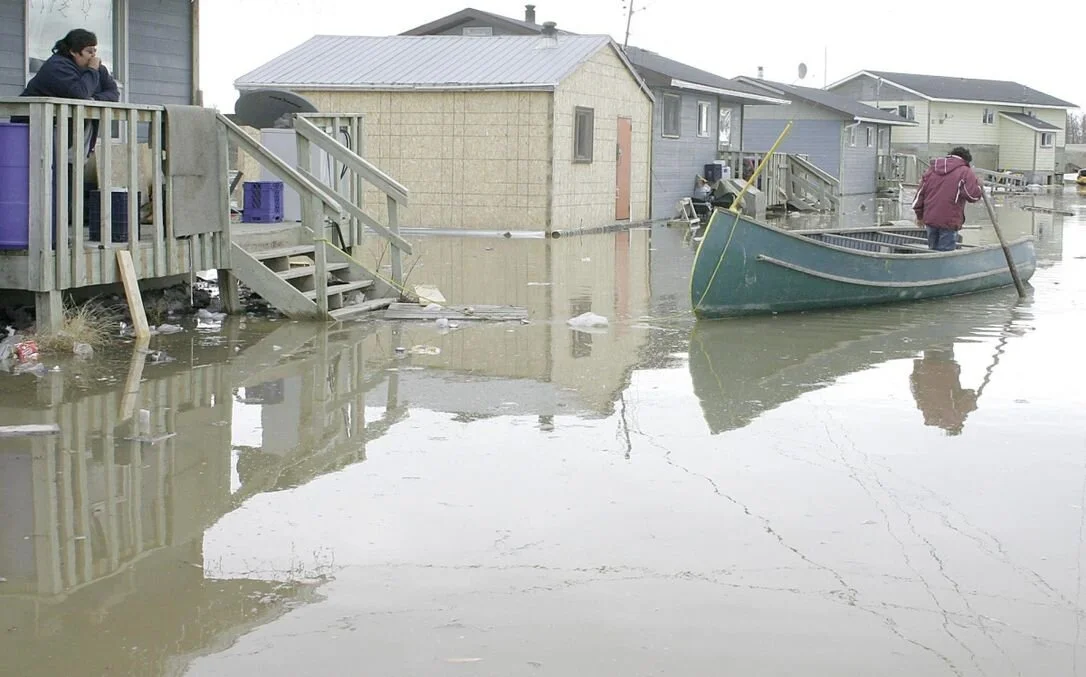Kashechewan, Ontario
The First Nation community of Kashechewan was first evacuated in 1976 as a result of flooding. The community has been evacuated every year since 2012, during which time homes have been demolished due to recurring flooding. The federal government has been promising to relocate Kashechewan for more than 15 years and have signed three agreements with the First Nation to relocate the community, though no actions have been taken.
Project Initiation
In 2006, Chief Friday presented a proposal to locate a new site for the community 30km west of the existing community on the Albany River. The Band Council had chosen the site.
In 2016, most community members in Kashechewan signed a referendum in favour of relocating to higher, drier ground upstream. An agreement is signed with the federal government.
In 2019, the federal and provincial governments sign an agreement committing to move the reserve within ten years.
Residents of Kashechewan First Nation in northern Ontario have endured flooding nearly every spring, such as this inundation in April 2006 SCOTT PARADIS / THE CANADIAN PRESS FILE PHOTO
Adaptation and Mitigation
In 1997, a dyke system was constructed around the community. In 2015, engineers reported the dyke ws inadequate to protect the community. The community is evacuated annually due to the flooding or risk of flooding. The plan to relocate would divert money from repairing the dyke walls and the funds used for evacuations to build a new community.
Process
In 2006, a community public forum was held where five site options were presented to the community for feedback. In 2006, the government appointed Alan Pope to consult with stakeholders and present a plan for relocation site options that offer the greatest advantages of improved economic and individual opportunities to members of the Kashechewan First Nation. As a result, Pope recommended a reserve be created on the outskirts, but within the geographic boundaries of the City of Timmins.
In 2019, the decision was made by the government to relocate Kashechewan to Site 5.
Site 5 location (CBC.ca 2019)
Community Engagement
After the Band Council chose the site without the input of the community, Chief Solomon was elected on the basis that the community be involved in the decision for the future location. The community was engaged through the public forum. In addition, through Pope’s study, every residence was canvassed for feedback on the 5 options presented and community members were asked to provide the ‘pros and cons’ of each site.
Outcomes
The process has started and stopped numerous times, leading to distrust in the government, rallies against the slow progress and a feeling of hopelessness.
References:
Kirkup, K. (April 15, 2019) Kashechewan First Nation face ‘massive trauma’ with flooding: MP. CTV News. https://www.ctvnews.ca/canada/kashechewan-first-nation-faces-massive-trauma-with-flooding-mp-1.4380397
Paling, E. (April 30, 2019) Kashechewan First Nation Has Been Evacuated Every Spring for 17 Years. Leaders Want Action. Huffington Post. https://www.huffingtonpost.ca/2019/04/29/kashechewan-first-nation-evacuated-every-spring-17-years_a_23719051/
Pope, A. (2006) Report on the Kashechewan First Nation and its People. Indian and Northern Affairs.
Sharp, M. (May 1, 2019) Decades after 1976 flood, Kashechewan First Nation still hopes to relocate. Canada’s National Observer. https://www.nationalobserver.com/2019/05/01/news/decades-after-1976-flood-kashechewan-first-nation-still-hopes-relocate
Stefanovich, O. (May 9, 2019) Kashechewan chief signs deal to move flood-prone community – but fears government won’t follow through. CBC News. https://www.cbc.ca/news/politics/stefanovich-kashechewan-2019-relocation-agreement-1.5129181
Talaga, T. (July 8, 2019) Holding Back the River. The Star. https://projects.thestar.com/climate-change-canada/ontario-eco-anxiety/
Together We Work for Hope, 2019 Framework Agreement for the safety, health and ongoing sustainability of Kashechewan First Nation. Government of Canada. (May 19, 2019)



